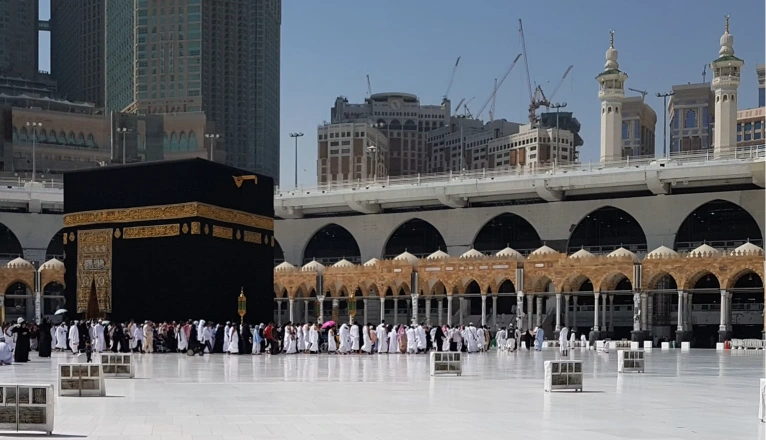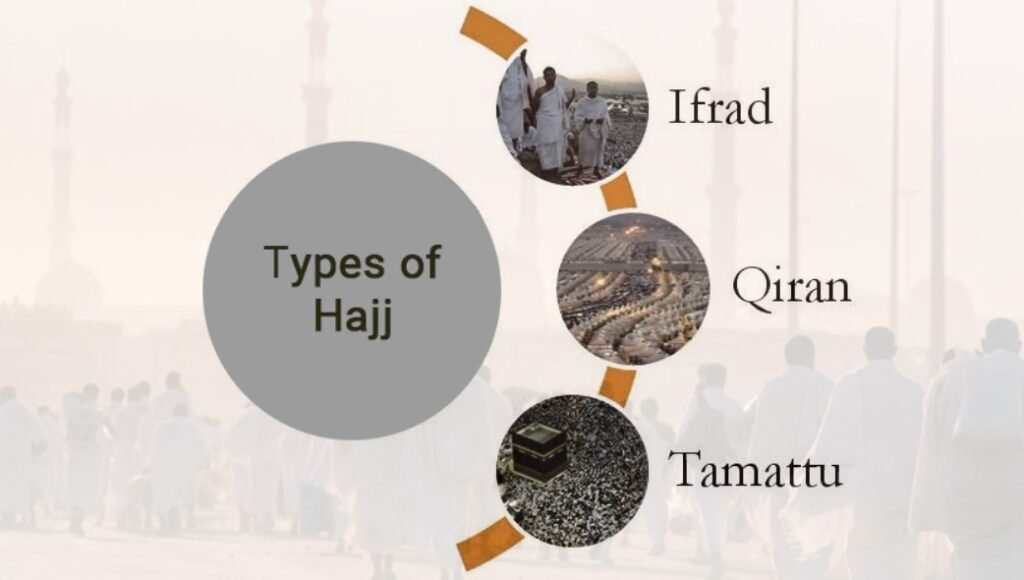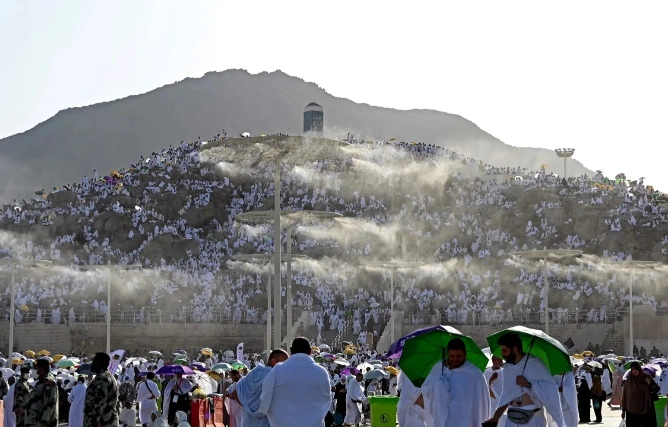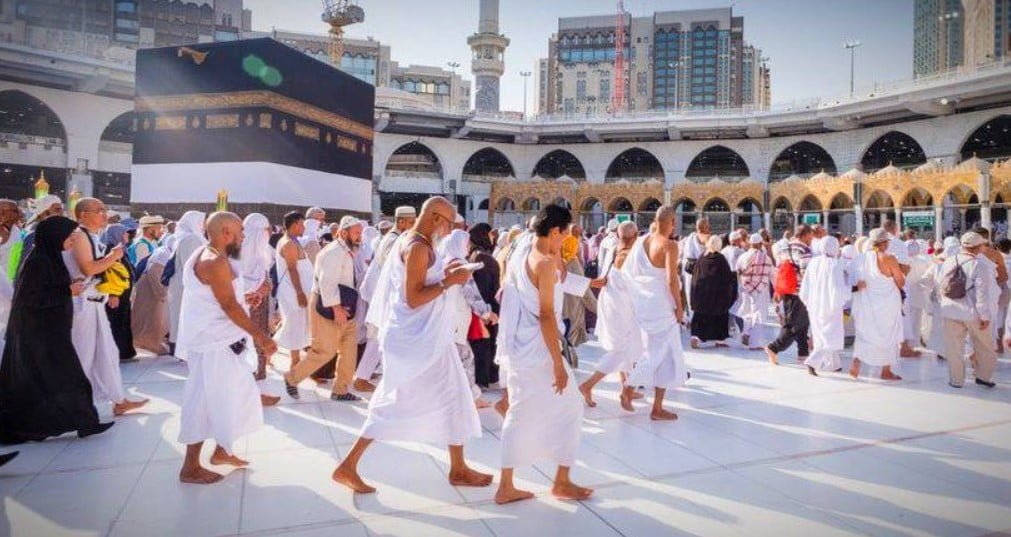To perform Hajj, the annual Islamic pilgrimage to Mecca is a deeply spiritual and transformative journey for millions of Muslims worldwide. It is one of the Five Pillars of Islam and holds immense significance in the lives of believers. This article will provide a comprehensive guide on performing Hajj, including its rituals, different types of Hajj, step-by-step instructions, and essential preparations.
The Importance of Hajj

Hajj is one of the Five Pillars of Islam, making it a religious obligation for every Muslim physically and financially capable of undertaking the journey. Also, It is not just a pilgrimage but a profound act of worship that holds immense spiritual significance. So, For many Muslims, performing Hajj is a lifelong dream. Completing this sacred duty strengthens their faith, enhances their spirituality, and provides a sense of fulfillment and closeness to Allah. Additionally, The experience of Hajj brings about a sense of unity among Muslims worldwide, as millions gather in Mecca with the same purpose and intention.
Historical Significance of Hajj
The rituals of Hajj date back to the time of Prophet Muhammad (peace be upon him) and commemorate the journey and trials of Prophet Abraham (Ibrahim) and his family. According to Islamic tradition, Allah commanded Abraham to leave his wife Hagar and their son Ismail in the desert of Mecca. In her search for water, Hagar ran between the hills of Safa and Marwah, which is reenacted during the Sa’i ritual. Abraham’s willingness to sacrifice his son in obedience to Allah’s command is remembered through the Qurbani (sacrifice) ritual. These events are deeply embedded in the Hajj rituals, connecting pilgrims to the profound acts of devotion and faith demonstrated by Abraham and his family.
Spiritual Journey of Hajj
Hajj is a time for profound self-reflection, seeking forgiveness, and reconnecting with Allah. Pilgrims leave behind their daily lives and embark on a journey that emphasizes the principles of unity, equality, and humility. Furthermore, The wearing of Ihram, the simple white garments, symbolizes purity and the stripping away of worldly distinctions, highlighting that all are equal in the eyes of Allah. Moreover, The various rituals of Hajj, from Tawaf around the Kaaba to standing at Arafat, offer opportunities for pilgrims to seek forgiveness, make supplications, and renew their faith. However, The experience of Hajj fosters a deep sense of humility and spiritual growth, leaving pilgrims transformed and rejuvenated in their faith.
Types of Hajj

1. Hajj al-Ifrad: This essentially refers to performing the rituals of Hajj alone without the need of a sacrificial animal (Hadee) or Qurbani. However, A pilgrim who undertakes this form of Hajj is called Mufrid.
2. Hajj al-Qiran: In this type of pilgrimage, one performs both Hajj and Umrah together while being in the state of Ihram. Furthermore, This form requires a sacrificial animal to complete the rituals. A pilgrim who undertakes this form of Hajj is called Qaarin.
3. Hajj al-Tamatt’u: The most common type of Hajj pilgrimage and the one Prophet Muhammed (PBUH) encouraged his companions to perform. Additionally, It refers to performing Umrah rituals during the Hajj season and then proceeding to complete the steps of Hajj between the 8th and 13th day of Dhu al-Hijjah. moreover, Both Umrah and Hajj rituals are performed by entering a separate state of Ihram, and a sacrificial animal is required to complete this form of Hajj. A pilgrim who undertakes this form of Hajj is called Muttamatti.
Preparations Before Hajj
Spiritual and Physical Preparation:
- Spiritual Readiness: Engage in sincere repentance, seek forgiveness, and strengthen your faith through prayer and study of the Quran.
- Physical Readiness: Maintain good health, engage in regular exercise to build stamina, and consult with a healthcare provider to ensure fitness for the journey.
Practical Preparations:

- Documentation: Obtain necessary travel documents, including a valid passport, visa, and Hajj permit.
- Financial Planning: Accordingly, Ensure you have sufficient funds to cover the costs of the pilgrimage and any dependents you leave behind.
Packing Essentials:
- Ihram Garments: Two white seamless clothes for men and simple, modest clothing for women.
- Comfortable Footwear: Suitable for long walks.
- Personal Care Items: Unscented toiletries, sunscreen, and hygiene products.
- Medication and First Aid: Necessary medications and a basic first aid kit.
- Religious Items: Quran, prayer mat, and guidebooks.
How to Perform Hajj? Rituals of Hajj
Entering the state of Ihram:

1. Miqat: At designated stations (Miqat), pilgrims don their Ihram garments and make the intention (Niyyah) for Hajj. Entering the state of Ihram signifies ritual purity. Furthermore, Men wear two pieces of unstitched white cloth, one wrapped around the waist and the other over the shoulder. Moreover, Women may wear any modest clothing that adheres to the principles of the Hijab but without face coverings. Additionally, Fully covering shoes are not permitted; sandals must be worn by both men and women.
Ihram signifies equality before Allah, removing distinctions of status, race, culture, and wealth. While in Ihram, one must avoid smoking, sexual relations, swearing, shaving hair, cutting nails, and using scented products.
2. Talbiyah: Recite the Talbiyah “Labbayka Allahumma Labbayk” , لبيك اللهم لبيكلبيك لا شريك لك لبيك as a declaration of intent and submission to Allah.
Pro Tip 1:
Carry extra Ihram clothing and invest in comfortable trekking sandals to prevent blisters and discomfort.
Tawaf: Circle around the Kaaba
1. Upon arrival in Mecca: Upon arrival at Masjid al-Haram in Makkah, you begin by performing Tawaf, which involves circling the Kaaba seven times in an anti-clockwise direction, starting and ending at the Black Stone. Voluntary prayers can be offered to thank Allah for a safe arrival.
- Perform Tawaf: Circle the Kaaba seven times in a counterclockwise direction.
- Maqam Ibrahim: If possible, pray two Rak’ahs at the Station of Abraham.
- Zamzam Water: Drink water from the Zamzam well.
Sa’i: Walking Between Safa and Marwah

1. Perform Sa’i: Following Tawaf, perform Sa’i, which entails walking and running between the hills of Safa and Marwa seven times, commemorating Hajar’s search for water for her son Isma’il. Additionally, This ritual symbolizes perseverance and faith.
2. Hair Cutting: After Sa’i, men will shave or clip their hair, while women will trim a small portion of their hair, marking the end of Umrah. Accordingly, Pilgrims can then exit the state of Ihram until the 8th of Dhul Hijjah.
3. Rest and Worship: With Umrah complete, spend the remaining days in Makkah engaging in worship and rest, preparing for the upcoming days of Hajj, which begin on the 8th of Dhul Hijjah.
4. Re-entering the State of Ihram (8th Dhul Hijjah): On the 8th of Dhul Hijjah, purify yourself and re-enter the state of Ihram, reciting the Talbiyah as you proceed to Mina.
Pro Tip 2:
Take your time and stay hydrated by drinking Zamzam water available between Safa and Marwa.
Mina
On the 8th of Dhul-Hijjah: The Tent City

1. Travel to Mina: Upon arriving in Mina, you’ll settle into your designated tent. Here, you will perform your prayers: Dhuhr, Asr, Maghrib, Isha, and Fajr, shortening the four-unit prayers to two units each, but not combining them, as per the Quranic guidelines.
2. Spend the night in prayer, reading the Qur’an, and preparing for the second day. Moreover, This is a crucial time for spiritual reflection and devotion, so make the most of this unique experience.
Pro Tip 3:
Exercise patience, as the tents may offer limited space, and you might find yourself in close quarters with other pilgrims. Also, The weather will likely be very hot, so stay hydrated. However, The Saudi authorities have set up cold water stations near all tents, so familiarize yourself with your surroundings. You might also notice Hajj workers regularly restocking complimentary cold drinks in cooler boxes near your tent. Moreover, Feel free to enjoy these to quench your thirst, but always keep in mind the spiritual significance of your presence here.
Arafat

On the 9th of Dhul-Hijjah: The Pinnacle of Hajj
1. Travel to Arafat: After praying fajr salat in Mina, you’ll then head to the plains of Arafah, reciting istaghfar [asking for forgiveness] and making supplications, marking the Day of Arafah when we ask Allah (SWT) for forgiveness for our sins. Furthermore, Upon reaching the plains of Mount Arafah, pilgrims observe dhuhr and asr prayers combined and shortened (two Rakat instead of four).
2. Khutba: On this day there, will be a sermon delivered from Masjid al-Nimra on Mount Arafah. Remember to listen to the khutbah if possible. Your group may also facilitate a translation of this sermon into English.
The day of Arafah is one of the most important days for Muslims, as Allah (SWT), in Surah al-Maidah of the Holy Qur’an, refers to the Day of Arafah as the Day on which He perfected His religion, completed His favors upon His beloved Prophet Muhammad (SAW), and approved Islam as a way of life!
The Prophet (SAW) also said:
“There is no day on which Allah frees people from the Fire more so than on the day of ‘Arafah. He comes close to those (people standing on ‘Arafah), and then He reveals before His Angels saying, ‘What are these people seeking.” (Muslim)
3. Wuquf: So, be sure to stand on the plains of Arafah and make lots of du’a, focussing your energy on Allah (SWT), asking Him for forgiveness and blessings for you and your family. Don’t forget to include your friends, relatives, neighbors as well as the wider Ummah in your du’a on this special day.
Pro Tip 4:
Don’t be tempted to exhaust your energy and trek up Mount Arafah, also known as Jabal al-Rahmah, on this day. Jabal al-Rahmah is the hill from where Prophet Muhammad (SAW) delivered his sermon. There is no authentic source to suggest any benefit in trekking the hill itself or undertaking this climb as a religious ritual. You should spend your time in contemplation and prayer on the level area surrounding the hill, called the Plains of Arafah.
Muzdalifah

After sunset on the 9th of Dhul-Hijjah: Under the Open Sky
1. Travel to Muzdalifah: After sunset, you’ll leave Arafah and proceed to Muzdalifah, an open area between Mina and Arafat. Upon reaching Muzdalifah, you will perform Maghrib and Isha prayers consecutively, shortening the Isha prayer to two units (Rakat).
Abdullah ibn Umar (RA) narrated:
“The Prophet (SAW) offered the Maghrib and Isha prayers together at Muzdalifah with a separate iqama for each of them and did not offer any optional prayer in between them or after each of them.” (Bukhari)
2. Pray and Rest: After praying, you can spend the night in worship or rest. Additionally, The Prophet (SAW) chose to sleep until just before Fajr, rather than engaging in his usual night worship. Therefore, it is wise to rest and conserve your energy for the demanding day ahead.
3. Pebbles collecting: While in Muzdalifah, you may also gather pebbles for the ritual stoning of the devil (rami) over the next three days. The pebbles should be about the size of date stones. You will need a total of 49 pebbles, distributed as follows: 
- 7 for the 10th of Dhul Hijjah
- 21 for the 11th of Dhul Hijjah
- 21 for the 12th of Dhul Hijjah
Pro Tip 5:
Additionally, it is recommended that you collect an extra 21 pebbles, bringing your total to 70, as a precaution in case you miss the target or drop some pebbles.
Eid Ul Adha: The 10th of Dhul Hijjah
Ramy al-Jamarat, Yawm al-Nahr (Day of Sacrifice):

1. Travel to Mina (Ramy al-Jamarat): After performing Fajr Salah, you will depart from Muzdalifah and head towards Mina, continuously reciting the Talbiyah along the way. Rami, or the stoning of the Jamarat, involves pilgrims throwing pebbles at three stone structures in Mina, symbolizing the rejection of Shaytan. Also, This ritual commemorates the actions of Ibrahim (AS) when he was commanded by Allah (SWT) to sacrifice his son, Ismail (AS). Also, Shaytan tried to dissuade Ibrahim, but upon the instruction of Angel Jibreel, Ibrahim threw stones at Shaytan at three locations, causing him to flee.
Once you reach Jamarat, proceed to Jamarat al-Aqaba, the largest pillar, and throw seven pebbles at it while saying “Allāhu Akbar” (Allah is The Greatest) with each throw.
2. Sacrifice (Nahr):  After the Rami, you will proceed with the sacrifice of an animal. Following this, men will shave or trim their hair, with shaving being the preferred practice as done by the Prophet Muhammad (SAW). Women will trim their hair by the length of a fingertip.
After the Rami, you will proceed with the sacrifice of an animal. Following this, men will shave or trim their hair, with shaving being the preferred practice as done by the Prophet Muhammad (SAW). Women will trim their hair by the length of a fingertip.
Once this is done, you can exit the state of Ihram and change into regular clothing. After Ihram, you can resume all activities that were restricted, except for sexual intimacy. Additionally, It is also Sunnah to apply perfume, as the Prophet Muhammad (SAW) was known to smell strongly of musk at this point.
3. Shave or Trim Hair: Halq (shaving the head) or Taqsir (clipping or shortening of the hair) is a significant ritual for both men and women during Hajj. For men, it is recommended to shave their heads completely or trim their hair short. However, women are not permitted to shave their heads; instead, they should only clip a lock or strand of their hair.
This act of cutting the hair symbolizes detachment from physical appearances and complete submission to Allah’s will.
Pro Tip 6:
To perform Hajj, there is no need to rush the Rami. The timeframe for completing it is from Fajr on the 10th until Fajr on the 11th. Hajj authorities often allocate specific times for groups to perform Rami to reduce overcrowding and ensure safety. However, Avoid throwing anything other than pebbles at the pillars, as doing so has no religious significance and could result in lost valuables.
Pro Tip 7:
If within a group, use disposable blades to shave each other’s heads. Alternatively, barbers in Mina can shave your head for a fee. Ensure barbers use new blades to prevent infections.
Tawaf al-Ifadah: Essential Ritual

1. Perform Tawaf al-Ifadah: Next, you will travel to Makkah to perform Tawaf al-Ifadha and Sa’i, which are essential parts of Hajj. Moreover, These rituals must be performed after the Rami, sacrifice, and shaving or trimming of the hair. You have from the 10th to the 12th of Dhul Hijjah to complete them.
2. Repeat Sa’i: Upon completing Tawaf al-Ifadha and Sa’i, you may fully relax and resume all activities that were restricted, including marital relations. However, you will return to Mina to continue the remaining Hajj rituals.
Pro Tip 8:
The Tawaf area will be extremely crowded during this period. Consider using the upper levels of the Haram or the roof, and try performing Tawaf around midnight when it is quieter.
Days of Tashreeq: Continued Rites
From the 11th to 13th of Dhul-Hijjah:
These days are known as “Ayyam al-tashreeq,” or the days of drying meat. During the time of the Prophet Muhammad (SAW), pilgrims would preserve the Qurbani meat by seasoning and drying it under the sun to prevent it from spoiling. The Prophet Muhammad (SAW) emphasized:
“The days of tashreeq are the days of eating and drinking.” (Muslim)
1. Return to Mina: Perform stoning at all three Jamrat each day.
You must stay in Mina and complete two more Rami rituals on the 11th and 12th of Dhul Hijjah. On the afternoon of the 11th of Dhul Hijjah, prepare your 21 pebbles and proceed to stone the three Jamarat. Begin with Jamarah al-Ula (the small pillar), then Jamarah al-Wusta (the middle pillar), and finally, Jamarah al-Aqaba (the big pillar). Each should be stoned with seven consecutive pebbles accompanied by takbeer. Pause after the first and middle Jamrat to make du’a facing the qibla. Remember to carry spare pebbles in case you lose some! After completing this, return to your camp in Mina and spend the remainder of the day in worship, making the most of the remaining time.
2. Stay in Mina: Engage in prayers, reflection, and remembrance of Allah. Repeat the same process the following day and stone the three Jamarat.
By this point, you should have completed all the rites of Hajj and be ready to depart for Makkah. Depending on your Hajj group’s itinerary, you may have a few rest days in Makkah or may depart immediately. Before leaving Makkah, however, you must perform the farewell Tawaf.
Final Tawaf: Farewell
Before leaving Mecca:

1. Perform Tawaf al-Wada: This Tawaf is obligatory and must be performed before leaving the boundaries of the Haram. Omitting it without a valid reason is not permissible in Islam. Ibn Abbas (RA) narrated: “The people were ordered to perform the Tawaf al-Wida as the last thing before leaving (Makkah), except for menstruating women who were excused.” (Bukhari)
2. Perform seven laps of Tawaf, followed by two Rakats of Salah and drinking Zam Zam water. There is no Sa’i or shaving/trimming of the head after this Tawaf.
Congratulations! You have now completed your Hajj!
After Hajj
Returning Home:
1. Reflect and Share: Reflect on the spiritual journey and share the experience with family and friends.
2. Continue Good Practices: Maintain the spiritual upliftment and continue to practice the good habits developed during Hajj.
Blessings During the First Ten Days of Dhul Hijjah
For those unable to perform Hajj, do not despair! The first ten days of Dhul Hijjah are significant, providing an opportunity to earn the mercy and forgiveness of Allah (SWT) after Ramadan.
Use this blessed time to increase in righteous deeds such as giving charity, honoring parents, maintaining family ties, and enjoining good and forbidding evil. Enhance obligatory acts of worship, be mindful of prayers, and pay Zakat promptly. Make sincere dua for the opportunity to perform Hajj soon.
The Prophet Muhammad (SAW) said:
“There are no days more beloved to Allah in which good deeds are more beloved than these ten days, so recite a great deal of tahleel, takbeer, and tahmeed during them.” (Ahmad)
- It is highly recommended to fast and engage in remembrance.
- Consider offering a sacrifice in remembrance of Prophet Ibrahim’s (AS) dedication to Allah (SWT) and supporting those in need.
- Give Zakat and Sadaqah during the blessed days of Dhul Hijjah and remember to arrange for Qurbani in time for Eid!
Step-to-Step Visual Guide:
Videos Source: @The Right Path
Read Also
What Is Hajj? The Importance Of Hajj In Islam-Etuitionsgateway
How To Memorize The Qur’an Through Easy Techniques & Methods
Final Words
Lastly, Embarking on the Hajj pilgrimage is a profound spiritual journey that unites Muslims from diverse backgrounds in devotion and unity. Also, With careful preparation and adherence to this detailed guide, pilgrims can undertake a transformative experience that leaves a lasting impression on their hearts and souls. May Allah accept the Hajj of all those who embark on this sacred pilgrimage, and may He shower His boundless mercy upon those unable to perform Hajj very soon. (In Sha Allah & Ameen).
Zilhajj Mubarak to all Muslims around the globe from EtuitionsGateway!

